We test dual SIM phones very often lately. Today we are going to present you the review of a very popular handset the Samsung С5212i. This is a low-end model as well as the majority of the phones with dual SIM function. Both SIMs can be active simultaneously and calls can be received on either number at any given time.
In the box, as well as the handset itself there is a wall charger, a set of headphones and a manual (Pic. 1, 2). Our Samsung С5212i is a black colored candy bar phone which is made of plastic (Pic. 3, 4).
We are really disappointed with the display resolution which is too low (176 x 220 ppi). The 1.3 camera is also very poor. The handset weighs 98 g. The battery capacity is 1000 mAh.
We like the Samsung С5212i’s build quality. All the components are firmly attached to each other. We heard no squeaks when we used the phone. Will it become a wrecked piece of plastic or will it survive and stay functional? Get through all the stress teats and you’ll know the result.
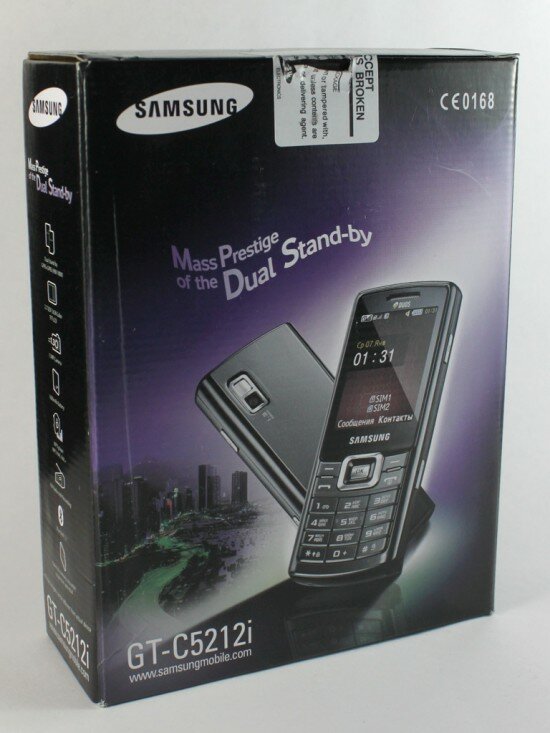
Рic. 1. Package box
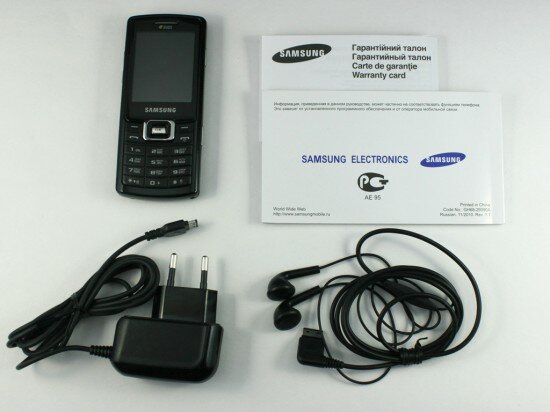
Рic. 2. Accessories
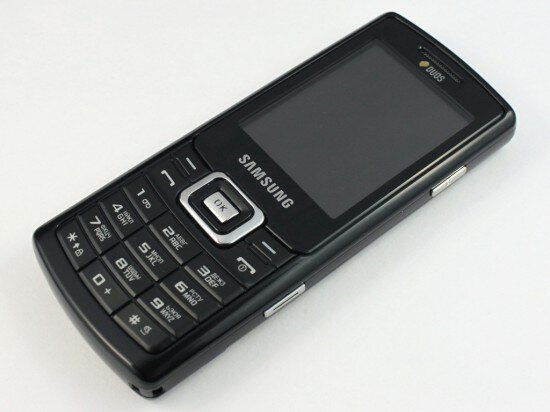
Рic. 3. The front panel
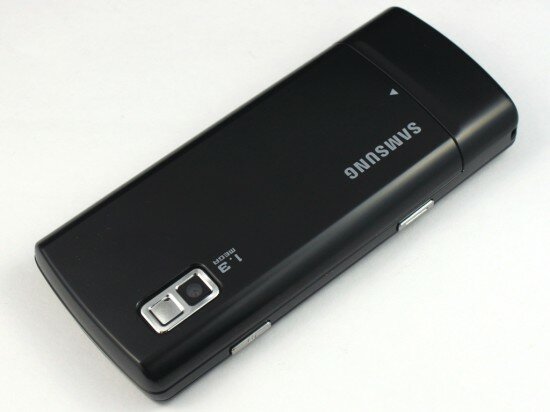
Рic. 4. The back panel
1. Samsung С5212i stress tests. Stage 1 — Light shocks
1.1 Drop tests
How many times did you drop your cell phone? One? More? During the 3 stages of this test we dropped the Samsung С5212i for 48 times. But we’ll tell you about each test in its own good time.
At the 1st stage of the test we dropped the gadget on the carpet (video 1) from 1 m (3.28 ft) and from 30 cm (11.8 inches) on the ceramic tile (video 2). The phone hit the carpet and the tile with each face, edge, and corner (6 drops on each type of flooring).
The device sustained no damage and stayed functional.
Video 1. Drops on the carpet from 1 m (3.28 ft)
Video 2. Drops on the tile from 30 cm (11.8 inches)
The grade for the drops on the carpet is 30 (with 30 being the highest possible grade)
The grade for the drops on the tile is 30 (with 30 being the highest possible grade)
1.2 Squeeze test
The squeeze test simulates situations when the users leave their cell phones on chairs, for example, and then sit on them.
We placed the Samsung С5212i on a table and applied a 3 kg (6.6 lbs) pressure from a wooden bar above it (Pic. 5).
The phone sustained no damage. We didn’t even heard a squeak.
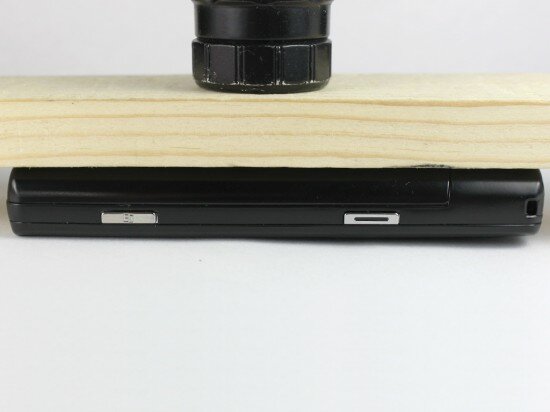
Pic. 5. The phone under the 3 kg (6.6 lbs) wooden bar
The grade is 24 (with 24 being the highest possible grade)
1.3 Bend test
If you sit on a chair with your cell phone in a back pants pocket you may bend it accidentally. The same happens when people step or sit on their phones that lie on a rough surface. This test is more dangerous for innards of the gadget than the squeeze test.
We put the Samsung С5212i onto the two planks so that each edge of the phone lies on a single plank. Then we hitched a string with 1 kg load (2.2 lbs) on top of the device.
The phone showed no bend.
The grade is 24 (with 24 being the highest possible grade)
1.4 Durability test
Are you curious about your mobile phone’s functionality and appearance after a long period of everyday use? We found out how the Samsung С5212i can look like with the help of the drum, devised especially for this test and filled with keys, pennies, and plastic balls. The drum was rotated for 5 minutes (video 3).
We can infer that this is not a robust gadget. We saw a lot of visible scuffs on the corners and on the screen (Pic. 6, 7). The rubber keyboard showed no damage. The chrome-effect volume rocker and the D-pad sustained visible scratches.
Video 3. Drum rotation
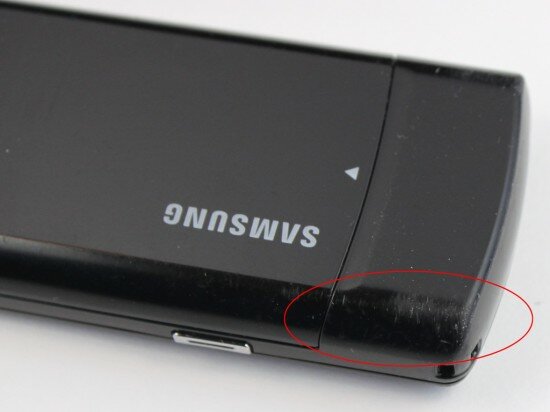
Pic. 6. Scratches on the casing
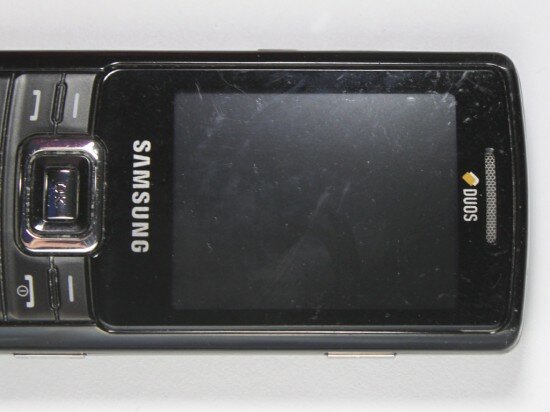
Pic. 7. The screen
The grade is 10 (with 15 being the highest possible grade)
1.5 Scratch test
We scratched the Samsung С5212i’s back cover and the screen in order to test the material of which the phone is made (video 4, 5). We attached a nail to the machine that had been devised especially for this test and successively applied 100 g (0.22 lbs) pressure from the nail above the phone’s screen and the casing. Next, we moved the phone as if taking it out from under the nail allowing the nail to scratch it.
The screen sustained a small scratch that was visible especially when the back light was on (see the picture at the 3rd stage of the test). The scratch on the back panel was also visible.
Video 4. Screen scratching
Video 5. Back panel scratching
The screen gets 10 points (with 15 being the highest possible grade)
The back panel gets 10 points (with 15 being the highest possible grade)
1.6 High temperature
In order to find out how the Samsung С5212i survives heat we performed the following test: placed the phone in a metallic container 5 cm from the electric bulb (40 Wt) that heated the phone for 3 min. (video 5).
The phone stayed absolutely functional after exposure to heat for short period. The temperature of the handset rose to 89 °С (192.2 °F) but the gadget didn’t melt.
The grade is 12 (with 12 being the highest possible grade)
1.7 Dust test
Dust that penetrates the casing and the connectors may have a bad impact on the phone’s functionality. That is why dust resistance plays a very important role for everyone who wants to buy a reliable handset.
We performed the dust test the following way: threw the gadget in the enclosed tray filled with dust and made it vibrate viciously for 2 min.
Here’s how the phone looks like after the test (Pic. 8). We saw a lot of dust in the battery slot (Pic. 9) that penetrated through the camera compartment on the back cover. The cap of the connectors didn’t prevent them from getting dirty (Pic. 10). The caps of some other phones showed the same result. We easily cleaned the gadget. The only problem for us was the dust that stuck in the gaps between the keys. But we got rid of them too (Pic. 11).
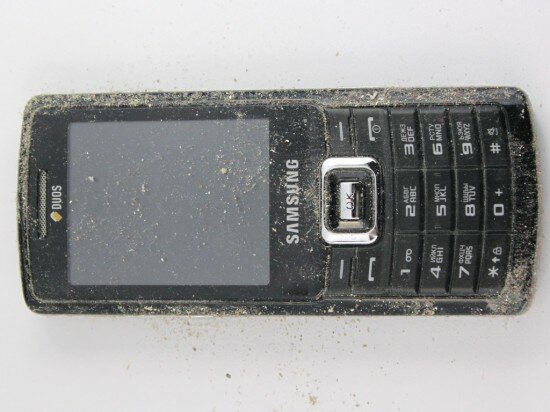
Pic. 8. Here
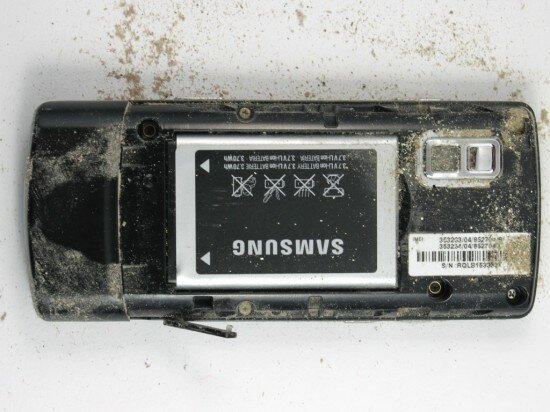
Pic. 9. Dust in the battery slot
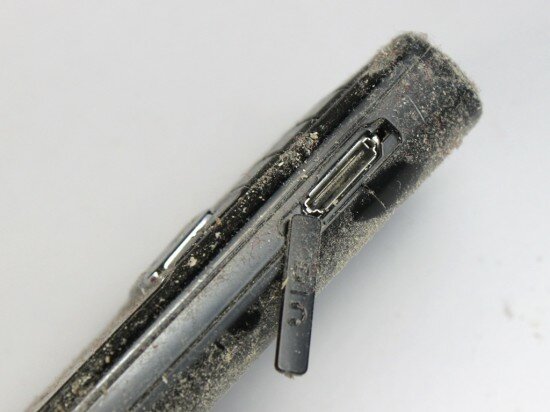
Pic. 10. Dirty connectors
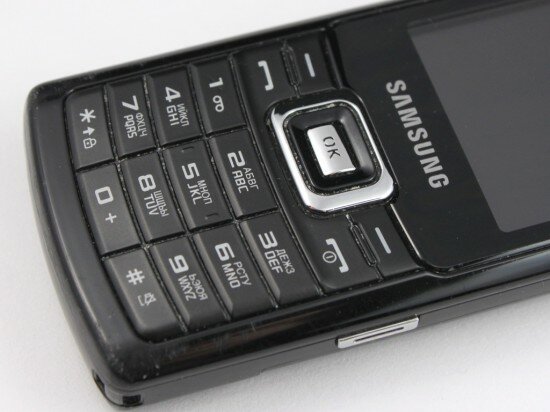
Pic. 11. Dust in the gaps between the keys
The grade is 12 (with 12 being the highest possible grade)
1.8 Signal strength test
The main function of any cell phone is to make and receive calls. This review won’t be finished until we test the Samsung С5212i’s reception quality.
So we placed the phone inside a box (video 6). Then we foiled the box. The foil cover didn’t allow the handset to receive the signal from towers. The signal could be obtained only through the hole in the box that we on purpose. The dimensions of the hole are the following: 40 x 50 mm (1.57 x 1.9 inches).
As a result, the signal strength fell by half. But the Samsung received all incoming calls with no problem.
Video 6. Signal strength test
The grade is 15 (with 15 being the highest possible grade)
After the 1st stage of the stress tests, the Samsung С5212i got 177 (with 192 being the highest possible grade)
2. Samsung С5212i stress tests. Stage 2 — Tough conditions
2.1 Drop test
At the 2nd stage of this test we dropped the phone from 1.5 m (4.9 ft) on the carpet (video 7) and from 50 cm (1.64 ft) on the tile (video 8).
The gadget sustained no damage. The back cover wasn’t removed by the bumps.
Video 7. Drops on the carpet from 1.5 m (4.9 ft)
Video 8. Drops on the tile from 50 cm (1.64 ft)
The grade for the drops on the carpet is 30 (with 30 being the highest possible grade)
The grade for the drops on the tile is also 30 (with 30 being the highest possible grade)
2.2 Squeeze test
We increased the applied pressure from the wooden bar above the phone to 10 kg (22 lbs).
The flat casing showed no damage. The handset successfully passed the test.
The grade is 24 (with 24 being the highest possible grade)
2.3 Bend test
This time, we increased the load by 5 times compared to the previous test.
The phone showed a very slight bend (Pic. 12).
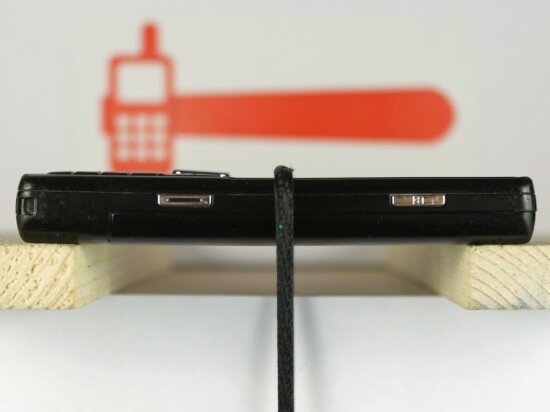
Рiс. 12. Bend inflicted by the 5 kg (11 lbs) weight
The grade is 24 (with 24 being the highest possible grade)
2.4 Durability test
This time, the Samsung С5212i spent 10 min. in the «time machine». After the experiment we saw more scuffs on the corners of the casing, compared to the previous durability test. Moreover, some scratches appeared on the central part of the back panel (Pic. 13, 14). The edges of the phone and the navigation key were also badly damaged (Pic. 16). The steel band near the camera compartment was deformed by the pennies and the keys in the drum (Pic. 17).
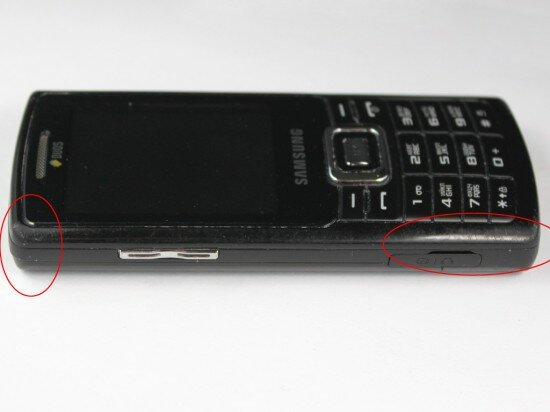
Pic. 13. Scuffs on the casing

Pic. 14. The corners of the phone
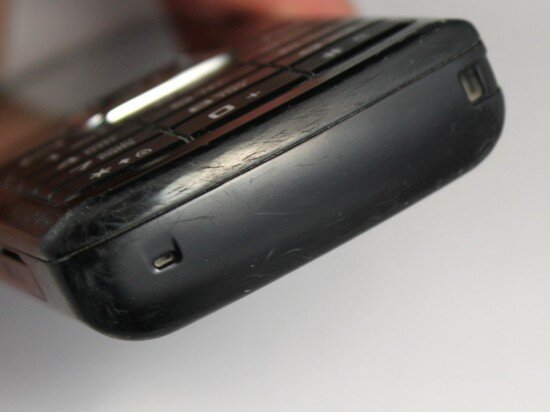
Pic. 15. Scratches on the panel
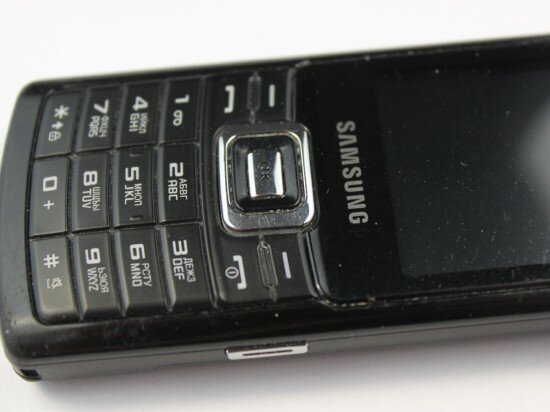
Pic. 16. Scratches on the navigation key
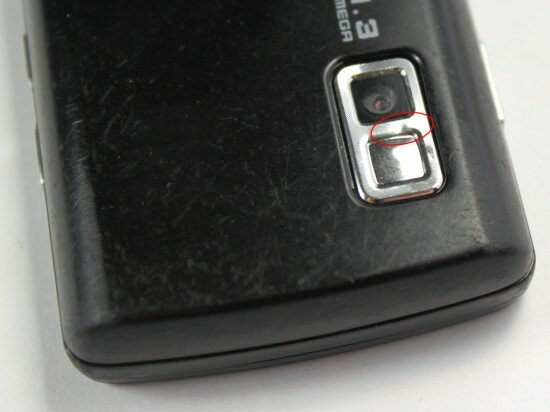
Pic. 17. Dent on the camera compartment
The grade is 10 (with 15 being the highest possible grade)
2.5 Scratch test
We increased the applied pressure above the screen and the back cover of the phone to 300 g (0.66 lbs) (video 9, 10).
The screen and the back panel sustained the scratches of medium size.
Video 9. Screen scratching (the force of scratches is 300 g (0.66 lbs))
Video 10. Back cover scratching (the force of scratches is 300 g (0.66 lbs))
The screen gets 10 points (with 15 being the highest possible grade)
The back cover gets 10 points (with 15 being the highest possible grade)
2.6 Freeze test
Everybody knows that cell phones are prone to malfunctioning in cold weather. The battery capacity goes down faster, compared to moderate temperatures. Cell phone hardware can be frozen and prone to cracking.
We placed the Samsung С5212i in a freezer and left it there in speaking mode for 2 hours. As a result, the battery stayed almost full (video 11). The display malfunctioned. Its resolution and color rendering changed for the worse. The rubber keys became stiff but we pressed them gently and they worked. The sound was fine, despite the snow that stuck in the speakers.
We warmed the phone and checked it again. The gadget was functional.
Video 11. Freeze test
The grade is 6 (with 18 being the highest possible grade)
2.7 Heat test
At the 2nd stage of this test we heated the С5212i for 5 min. (video 12). According to our pyrometer the phone’s temperature rose to 109 °С (228 °F). Fortunately, nothing melted because the period of the test was quite short. The rubber keys blew up but stayed functional. When we cooled the phone it started to look like it did before the test.
Video 12. Heat test
The grade is 12 (with 12 being the highest possible grade)
2.8 Immersion in water
If you remember our previous cell phone reviews, the majority of the gadgets stay functional after being completely submerged in water. In order to save your handset from damaging, you should take out the battery immediately and dry the phone as long as you can.
At first, we dunked the Samsung С5212i under water for 1 sec. (video 13). After the test, the phone performed pretty fine. The sound from the speakers didn’t change for the worse. We saw the drops of water in the battery slot but the circuit board stayed dry.
Video 13. Immersion in water for 1 sec.
The grade is 30 (with 30 being the highest possible grade)
2.9 Dust test
At the 2nd stage of the dust test our machine shook the enclosed tray containing the Samsung and dust for 5 min. As a result, we saw much more dirt in the battery slot (Pic. 18). A lot of dust penetrated the phone through the external antenna jack that is located right under the back cover. The connectors were dirtier, compared to the previous test. The keyboard sustained no damage. The sound from the speakers stayed fine.
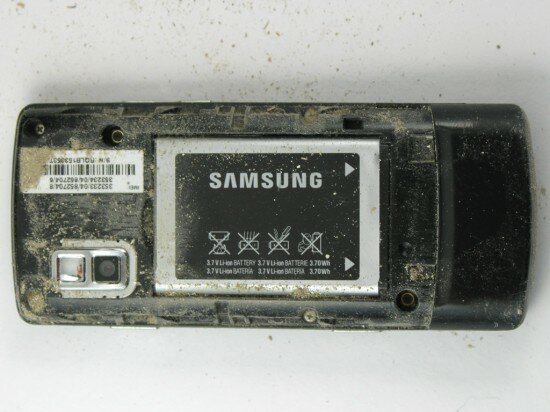
Pic. 18. Dust in the battery slot
The grade is 3 (with 3 being the highest possible grade)
2.10 Signal strength test
We decreased the size of the hole to 20 x 20 mm (0.787 x 0.787 inches) (video 13). The first incoming call was dropped but all the others were successfully receive by the Samsung. The strength of the signal was represented only by 1 bar (sometimes by 2 from a maximum 6).
Video 14. Signal strength test
The grade is 10 (with 15 being the highest possible grade)
After the 2nd stage of the stress tests, the Samsung С5212i got 220 (with 240 being the highest possible grade)
3. Samsung С5212 stress tests. Stage 3 — The toughest conditions
3.1 Drop test
The heights from which we dropped the phone on the carpet at the 3rd stage of the test were 2 m (6.56 ft). And we dropped the handset on the tile from 1 m (3.28 ft) (video 15, 16).
The Samsung survived the drops on the carpet. But when the phone hit the tile the back fell off for the first time in this test but we didn’t see any visible damage.
Video 15. Drops on the carpet from 2 m (6.56 ft)
Video 16. Drops on the tile from 1 m (3.28 ft)
The grade for the drops on the carpet is 30 (with 30 being the highest possible grade)
The grade for the drops on the tile is 30 (with 30 being the highest possible grade)
3.2 Squeeze test
We increased the pressure we applied to 20 kg (44 lbs). When we placed the wooden bar on the phone we heard an unpleasant noise produced by the grains of sand that penetrated the seams of the phone during the dust tests. The С5212i showed no damage and stayed absolutely functional.
The grade is 24 (with 24 being the highest possible grade)
3.3 Bend test
We applied 10 kg (22 lbs) weight in our attempt to bend the Samsung. As a result, we saw a slight bend but the phone restored its previous shape after the test and stayed safe.
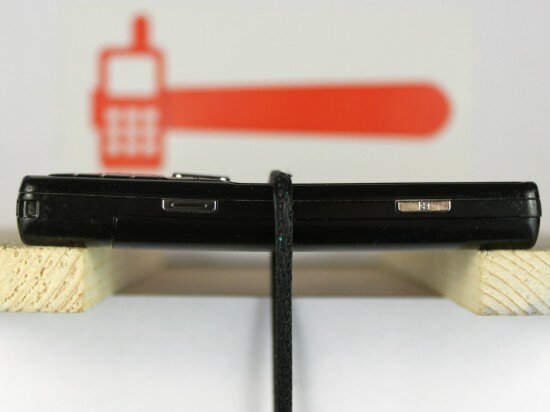
Pic. 19. Bend inflicted by 10 kg (22 lbs) weight
The grade is 24 (with 24 being the highest possible grade)
3.4 Durability test
At the last stage of the durability test the drum was rotated for 20 min. As a result, the gadget showed a lot of damage (Pic. 21, 22). The most vulnerable parts of the phone were completely scratched. In some locations we could see the paint through the loads of straight lines. The scuffs on the screen ruined the picture (Pic. 22). The chrome navigation key and the volume rocker were scratched so much that it seemed that they became matted.
The Samsung B5722 showed the same results, by the way. So we can infer that the quality of the Samsung’s material leaves much to be desired.
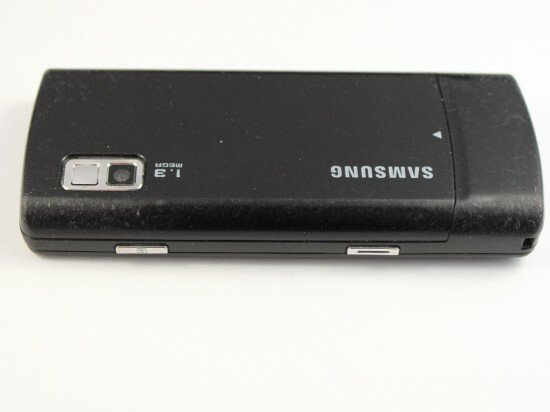
Pic. 20. Scratches on different parts of the phone
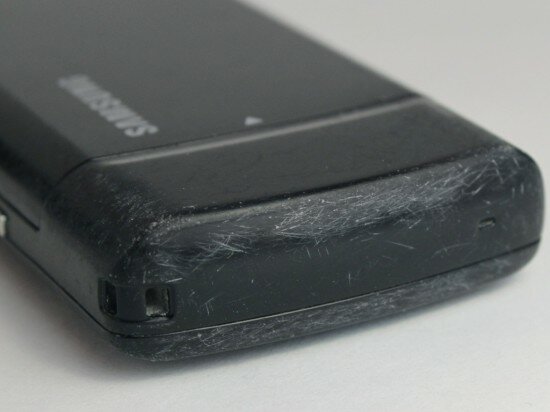
Pic. 21. The edges of the phone
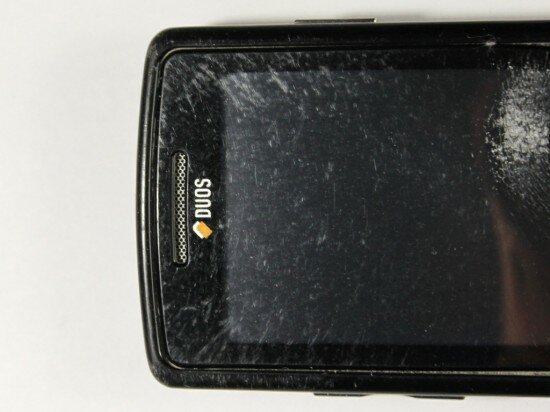
Pic. 22. The screen
The grade is 10 (with 15 being the highest possible grade)
3.5 Scratch test
We applied 600 g (1.322 lbs) pressure from the nail above the phone. We didn’t expect such a bad result. The screen showed a very deep scratch. It struck the eye when the back light was off and it ruined the picture when the back light was on (Pic. 24, 25). The back panel also showed a deep scratch (Pic. 25).
Video 17. Screen scratching
Video 18. Back panel scratching
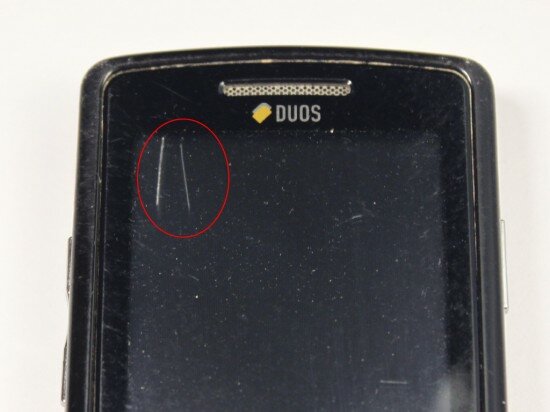
Pic. 23. Scratches on the screen
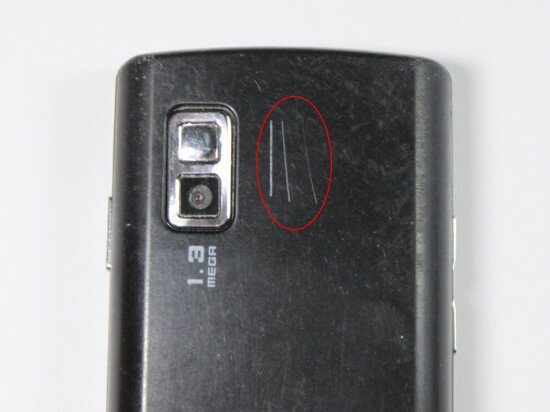
Pic. 25. Scratches on the back panel
10 points for the screen (with 15 being the highest possible grade) for the screen
10 points for the back cover (with 15 being the highest possible grade) for the back cover
3.6 Heat test
At the last stage, we heated the Samsung С5212i for 10 min. (video 19). After 8 min. of heating we heard the sound produced by the keys. They were deformed by the rays of the electric bulb and pressed by themselves. The shutter on the camera opened and closed for several times. When the time of the test was over we took the phone out. The appearance shocked us. We had never seen a cell phone that was melted so much (Pic. 26, 27). More exactly, the protective screen glass was damaged. The temperature of the handset rose to 130 °С (266 °F). At first time, the phone malfunctioned. But we cooled the gadget and it started to perform fine again.
We found out the two pictures that were taken by the camera during the heat test. The second picture is darker than the first. So we should infer that the heat ruined the camera quality which resulted in dark pictures.
Video 19. Heat test
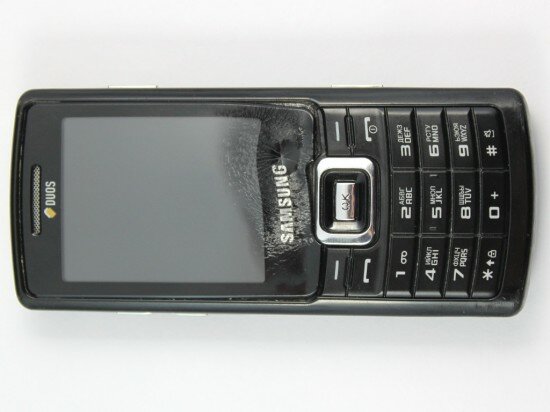
Pic. 26. Here’s how the protective screen glass was damaged
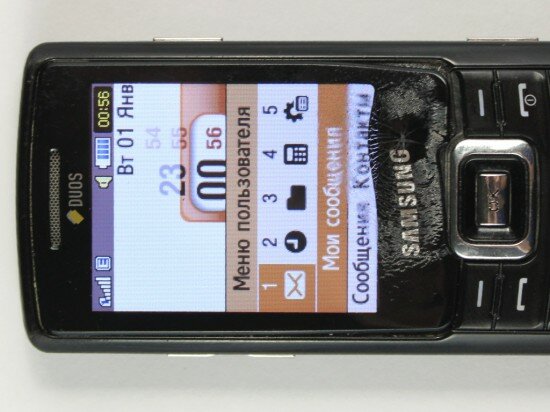
Pic. 27. Here’s how the picture on the screen was ruined
The grade is 8 (with 12 being the highest possible grade)
3.7 Immersion in water
The 2nd immersion lasted for 20 sec. (video 20). Water penetrated the speakers and ruined the sound quality (Pic. 28). Water penetrated the phone through the battery slot and the reached the circuit board. The USB port also got wet (Pic. 29).
We dried the phone for an hour and examined it thoroughly. A bit later we found out that the gadget charging from time to time. We couldn’t properly plug the USB cable in the port. So we used some alcohol to clean the USB port and plugged the cable with no problem.
So we have to lower the grade for the Samsung С5212i to 10 points.
Video 20. Immersion in water for 20 sec.
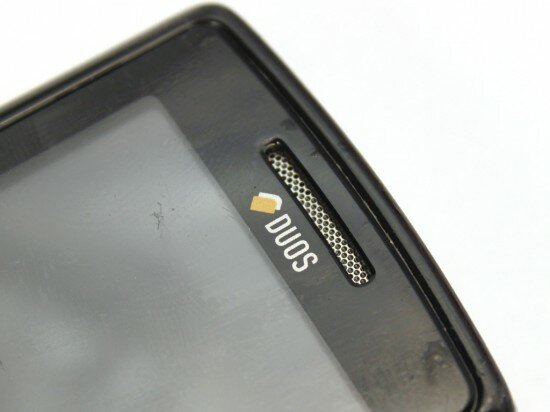
Pic. 28. The loudspeaker
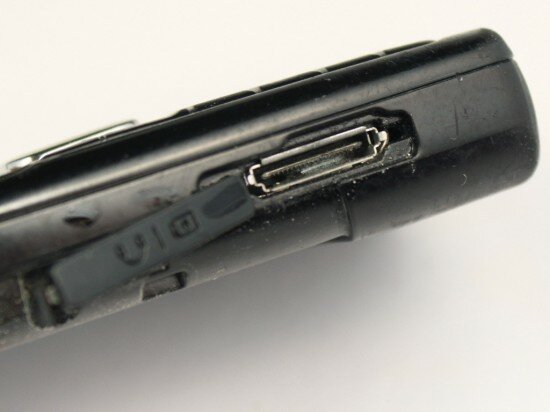
Pic. 29. The USB port
The grade is 10 (with 30 being the highest possible grade)
3.8 Immersion in beer
In this test we dunked the phone under beer. What for? For the sake of science! To tell exactly, to find out what would happen to your Samsung С5212i if you pour a glass of beer on it. The immersion lasted for 10 sec. (video 21).
The charger jack stayed absolutely dry (Pic. 30). We saw a few drops of beer in the battery slot. We washed the gadget and dried it out. After this, we examined the device. It performed pretty fine.
Video 21. Immersion in beer for 10 sec.
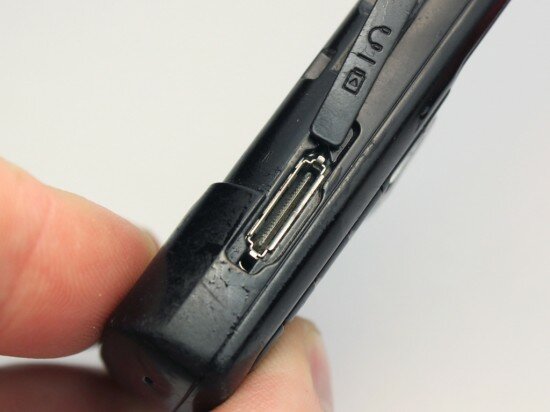
Pic. 30. The charger jack stayed dry
The grade is 9 (with 9 being the highest possible grade)
3.9 Dust test
At the last stage of this test, the Samsung С5212 spent 10 min. in the tray filled with dust.
The phone showed poor results as we found lots of dust in the battery slot (Pic. 31). Despite the cap, the charger jack was also very dirty (Pic. 32). Never plug a wall charger in the dirty jack. You may break it.
We were glad to witness the absence of dust under the melted screen. The keyboard worked perfectly.
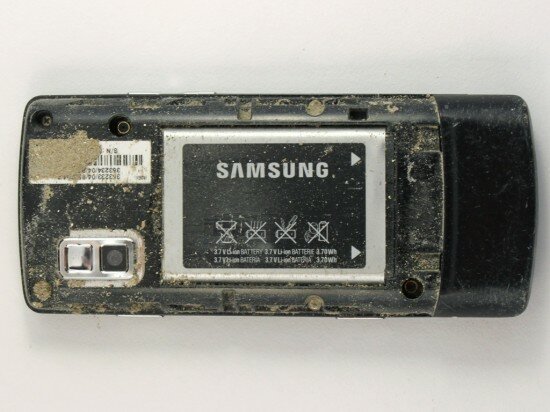
Pic. 31. Dust in the battery slot
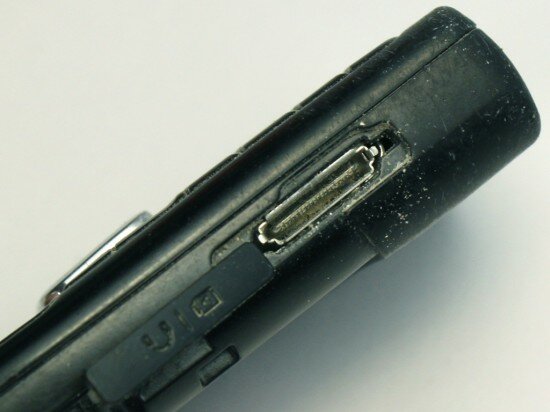
Pic. 32. Dust in the charger jack
The grade is 12 (with 12 being the highest possible grade)
3.10 The keyboard
The solid rubber keyboard is absolutely dust resistant. They say that such keyboards are not comfortable to use but we can’t say the same about the Samsung C5212’s keyboard.
The keys blew up during the heat test but stayed functional. They became a bit stiff in the cold but we pressed them with no problem. The keyboard is the only part of the phone that didn’t sustain any damage after the durability tests.
The navigation key and the volume rocker is the other case. They have a chrome effect that will be gone sooner or later.
The grade is 30 (with 30 being the highest possible grade)
3.11 Signal strength test
In the last test we decreased the size of the hole in the shielded box to 15 x 15 mm (0.59 x 0.59 inches) (video 22). The signal strength fell to zero. Sometimes we saw one bar on the screen. The reception was poor. 3 incoming calls were dropped. Sometimes the phone needed more time to receive a call that it does in normal conditions.
Video 22. Signal strength test
The grade is 10 (with 15 being the highest possible grade)
3.12 Short circuits and overcharge
At the end we checked how the Samsung С5212i’s circuits can withstand electrical overloads. First of all we found out what would happen to the battery charger if we made a short circuit of the power supply terminals with the help of the forceps for 1 sec. (video 23).
We heard a squeak but the wall charger stayed functional.
Video 23. Short circuit of the battery charger
We tested the battery the same way (video 24). The battery stayed functional too.
Video 24. Short circuit of the battery
At last, we tested the circuits that are responsible for charging. We plugged the battery charger in the PSU and the PSU in the phone (video 25).
The circuits in the cell phone survived the increase in charging voltage with no problem. The current consumption was stable. We did not expect to witness such a good performance.
However, there were some problems with the decrease in charging voltage. According to the ammeter the charging was stopped earlier that it was shown by the phone. The Samsung warned us that the charging was over only when we reduced the voltage to 3.8 V. We have to lower the grade for the phone because of this malfunction.
Video 25. Increase/decrease in charging voltage
Finally, we tested the ability of the circuit board to withstand the increase in energy supply. We took out the battery and plugged the PSU in the phone. But we couldn’t even switch on the phone using the PSU. The HTC Desire, for example, behaved right the same way. There are some tricks that can help to reboot the phone in such situations. But none of them worked. So we had to stop this test and put an excellent grade for the Samsung С5212i.
Video 26. Increase in energy supply
The battery charger (short circuit) gets 15 (with 15 being the highest possible grade)
The battery (short circuit) gets 15 (with 15 being the highest possible grade)
The grade for the increase/decrease in charging voltage is 15 (with 15 being the highest possible grade)
The grade for the increase/decrease in energy supply is 0 (with 15 being the highest possible grade)
3.13 Disassembling
Except dust (Pic. 33) that penetrated deep inside the phone we found a lot of interesting facts when we disassembled the Samsung С5212i (Pic. 34).
The keyboard is attached to a separate panel. But this is done not only for the sake of reliability but also because of the lack of space on the circuit board which has too many elements (Pic. 35, 36). The display is soldered to the board and it’s very difficult to separate them. The vibrate key and the volume rocker are also soldered to the board. The majority of the elements are protected by the removable shields. There’s only one speaker. It is used for the calls and for the media player.
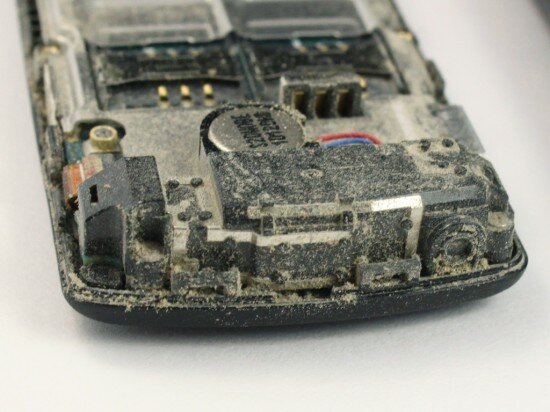
Pic. 33. Dust inside the phone
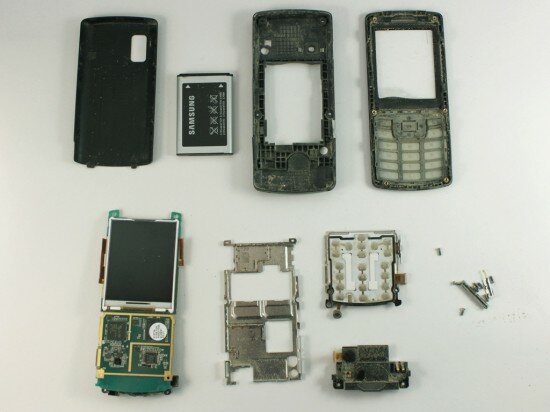
Pic. 34. The Samsung С5212 disassembled

Pic. 35. The front side of the circuit board
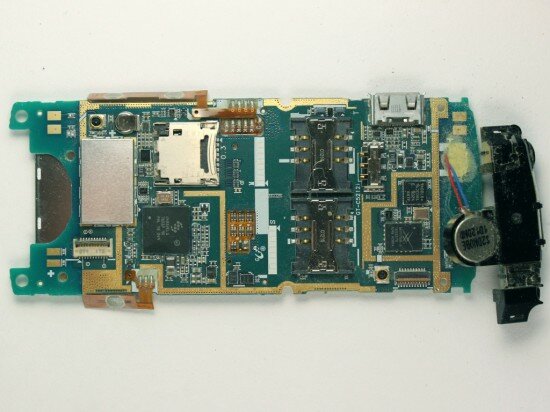
Pic. 36. The rear side of the circuit board
The grade is 30 (with 30 being the highest possible grade)
After the 3rd stage of the stress tests, the Samsung С5212i got 307 points (with 351 being the highest possible grade)
Final words
Let’s sum up all the results of this stress test.
The Samsung С5212i stayed absolutely functional and survived all the tortures. That’s great. But the appearance of the phone changed much for the worse. It reminds us about the Samsung B5722 that looked ugly after the durability tests. The С5212i’s scratch resistance is also very poor. The results of the heat tests were awful. We didn’t even think that the screen glass could melt so much. And finally, the problems with charging after the water test. The ability to receive calls in conditions of signal reduction leaves much to be desired. However, after each review we mention one and the same disadvantages. So there is nothing than can really surprise us.
As for the advantages, we can name the keyboard. This is not perfect but it survived the heat and the cold with no problem. The keyboard is absolutely dust proof and it’s the only part of the phone that stayed attractive after the tests.
There’s one more interesting fact: the Samsung С5212i showed the same fine results in the drop tests as the other dual SIM phone LG GX200.
Here’s how the Samsung С5212i looks like after all the tests (Pic. 37, 38, video 27).
Video 27. Here’s how the phone looks like after all the tests
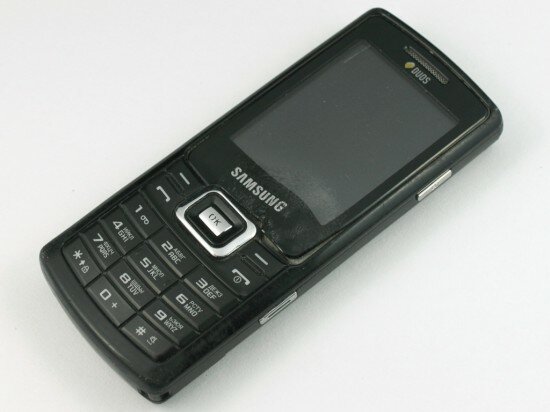
Pic. 37. Here
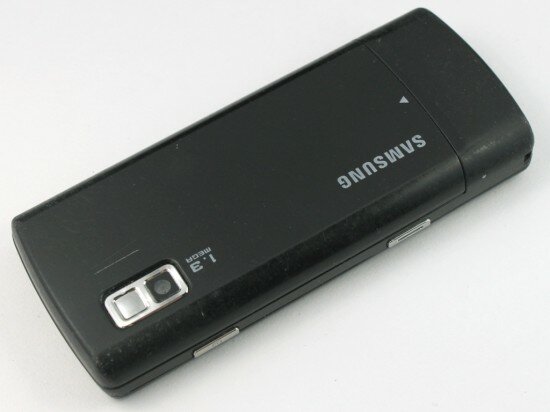
Рiс. 38. Here

 Russian version
Russian version